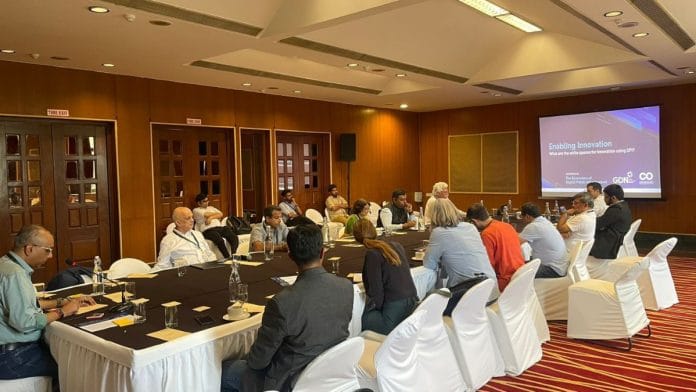New Delhi: From digital identification systems like Aadhaar to real-time, digital payment platforms like Unified Payments Interface—India’s Digital Public Infrastructure was dissected at a day-long conference at the India Habitat Centre, New Delhi.
The Economics of Digital Public Infrastructure was co-hosted by the Global Development Network (GDN), a network of research and policy institutes and Co-Develop, a global fund supporting countries building Digital Public Infrastructure. Through seminar-style discussions, the conference addressed the design, deployment and impact of DPI.
“Innovation in DPI is happening at three levels,” said R Chandrashekhar, Chairman of the Centre for the Digital Future (CDF), speaking at a roundtable discussion on white spaces for innovation using DPI. “First is at the technology level, like the analysis of X-Rays and MRIs. The second is at a process or enterprise level.”
Innovation at the third level—the ecosystem—enables entire services to become more affordable and accessible, he added. The payment ecosystem in India underwent a renaissance when UPI was launched. It brought digital payments to rural areas, integrated it with government services like toll payments and subsidies, and today handles massive transaction volumes. In May 2025, the value of UPI transactions touched Rs 25,14,297 crore.
“Many people think that the government and innovation are antonyms, but we cannot ignore the government’s role. Especially at the ecosystem level,” said Chandrashekhar, adding that his experience of setting up digital community service centres in rural areas showed him how DPI can be used as a fulcrum to rethink the entire ecosystem.
Also read: Rajasthan’s elderly are victims of ‘digital murder’. eKYC gaps leave lakhs without pension
Testing solutions
As the session progressed, researchers, academics and non-profit foundation members added their two cents about innovation in DPI. Nishant Saxena, from the Piramal Foundation, said they were enabling the government to rethink their scholarship methodology.
“In partnership with EkStep Foundation [a non-profit organisation founded by Nandan Nilekani], we are ensuring students receive scholarship disbursements instantly via digital wallets,” he said, gesturing to moderator Shankar Maruwada, co-founder of EkStep. What was once a long, drawn-out process involving paperwork and months of back and forth has been drastically cut down using DPI.
Pawan Bakshi, from the Gates Foundation, decided to take a step back and look at the big picture instead. For him, there was a need to first have a mechanism to identify problems and then highlight them to people across domains for addressing them.
“Even if you do have a solution, how do you test it out?” he said, highlighting the need for a sandbox—a safe testing space with low risk—to check the efficacy of solutions.
In the conference room next door, a parallel discussion was taking place, centred around the state of economic research on DPI. For the fifteen attendees, the biggest pain point was when other countries ask for evidence of DPI’s impact. After India’s success with UPI, the country is trying to export the model to other geographies.
“What we need is a study which takes the same sector in two countries, which are as close as possible to being an apples versus apples comparison,” said moderator Jean-Louis Arcand, President of GDN, who attempted to provide a solution. “And in a qualitative fashion, one sector shows what more has been brought by the DPI approach. For this, we need some kind of international collaboration.”
Also read: Inside CCMB Hyderabad—where scientists turn elephant blood, tiger bones into criminal evidence
The focus of DPI
In between sessions, attendees interacted with each other over lunch and coffee breaks, exchanging business cards and notes. For Steve Haley, Director of Market Development and Partnerships at Mojaloop Foundation, the economics of DPI is particularly important when dealing with payments.
“Payments are usually left to the private sector,” said Haley, an American who has been living in India for the last five years. “We need to view payments the same way we view any public utility—like roads, water and identification. We have an open-source fund that helps people with building national payment systems.”
But the jury is still out on the pricing associated with DPI, particularly questions around who bears the cost for this infrastructure. In a seminar on underlying costs, one attendee noted that most of India’s DPI runs in massive deficits.
“A lot of research needs to be done on sustainability and pricing,” he said, adding that foreign countries are asking questions on the revenue pipeline and how they are going to maintain the infrastructure. “In our country, private authentication has a fee, but government authentication is free. So, if it’s a government-built system, should government requests also be charged?”
Another attendee responded that all services should be priced, either at private sector levels or even nominal amounts, just to incorporate accountability. Sushant Kumar, founder and CEO of Kalpa Impact, said his organisation was looking at implementations across countries to assess costs, and their research could be of help.
“The government decision makers would find this valuable—both in terms of what it takes to put something together and what the current pricing mechanism is,” he said.
As the session was reaching a conclusion, Shubhashis Gangopadhyay, the Managing Trustee of India Development Foundation, offered a different perspective on the discussion around costs. For him, the focus should not be on recovering costs associated with DPI but on reaching the maximum number of people and adding societal value.
“Whether DPI has to be subsidised or we recover the money is not the issue,” said Gangopadhyay, adding that attempts will always be made to build at the least possible cost. “But our goal is that everyone can go anywhere in the country and use these services. Which of these DPIs satisfies this? I think Aadhaar.”
(Edited by Theres Sudeep)






